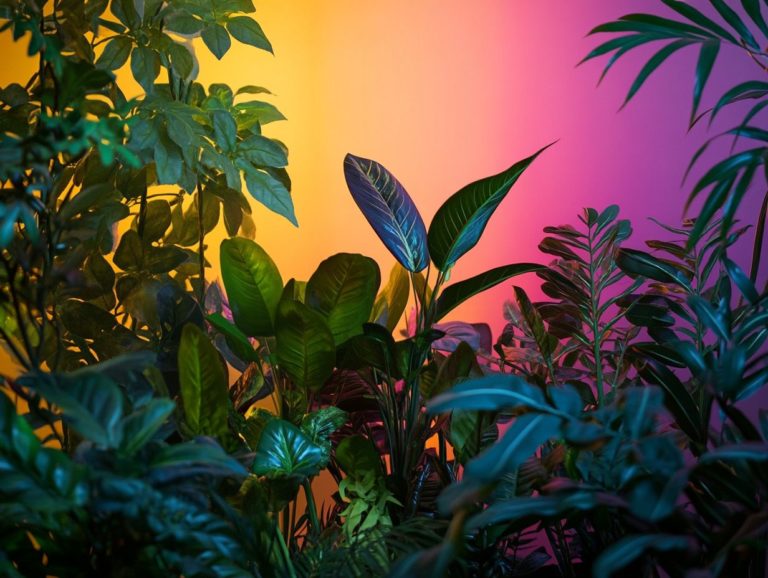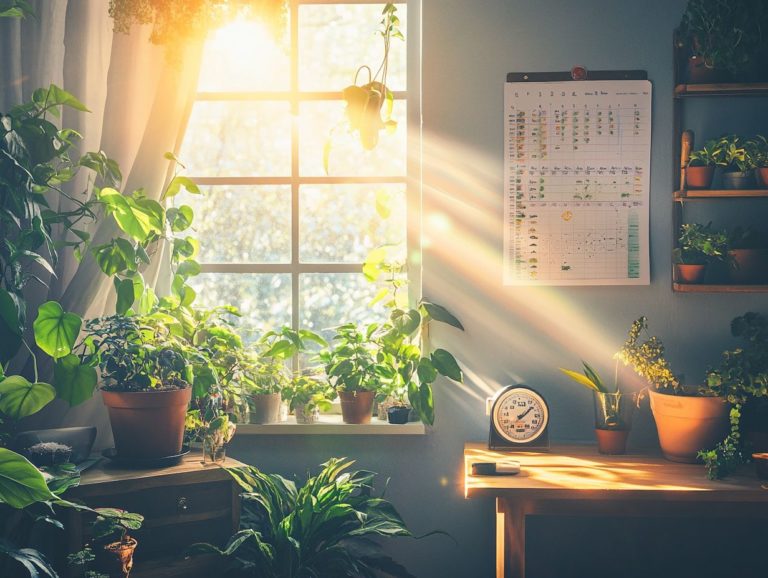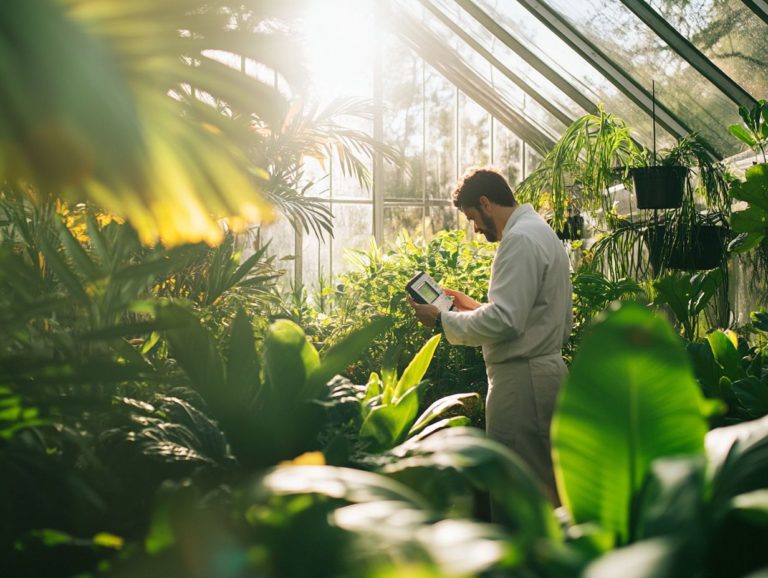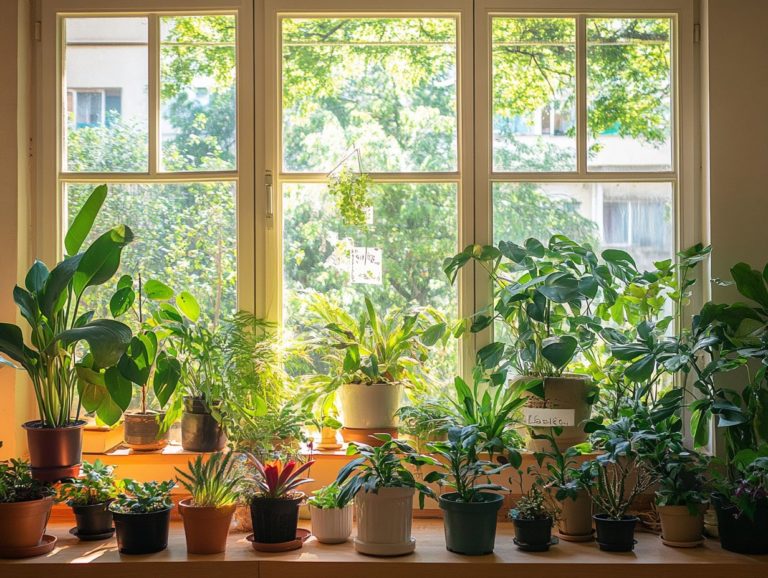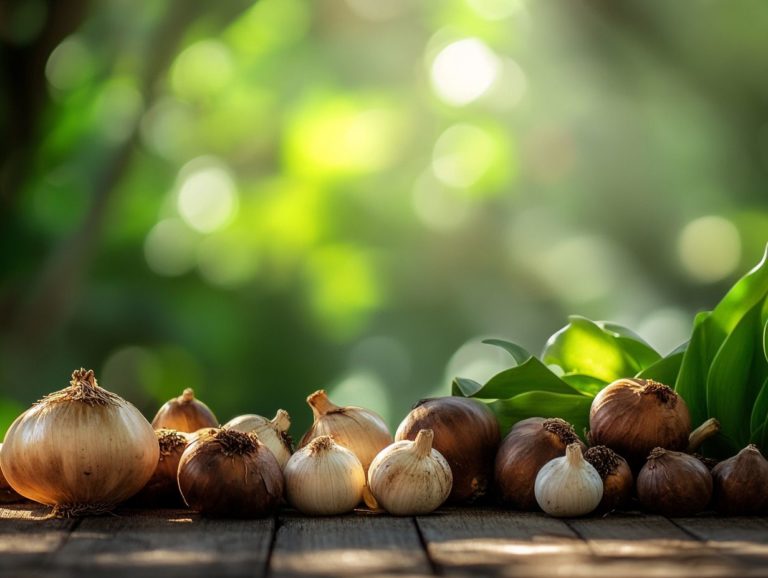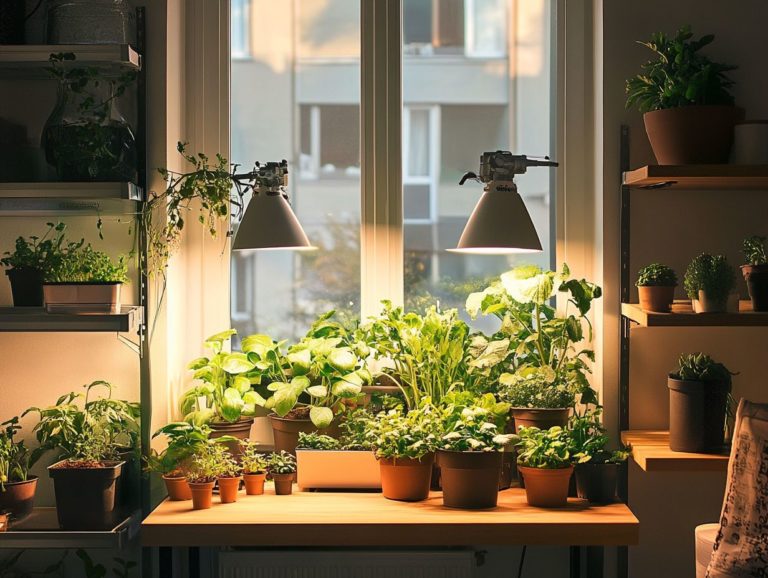Best Indoor Plants for Bright Light
Looking to infuse your home with a touch of vitality? Bright light indoor plants offer an exquisite way to elevate your space while enjoying the many benefits of greenery.
In this article, discover 15 stunning plants, from the resilient Snake Plant to the striking Bird of Paradise ideal for sunny spots in your home.
Essential care tips, common pitfalls to avoid like incorrect watering, and imaginative ways to weave these vibrant plants into your decor are included. Get ready to turn your living space into a vibrant oasis!
Contents
- Key Takeaways:
- 1. Snake Plant
- 2. Aloe Vera
- 3. Spider Plant
- 4. Jade Plant
- 5. Dracaena
- 6. ZZ Plant
- 7. Rubber Plant
- 8. Ponytail Palm
- 9. Ficus
- 10. Peace Lily
- 11. Philodendron
- 12. Chinese Evergreen
- 13. Monstera
- 14. Pothos
- 15. Bird of Paradise
- How to Care for Indoor Plants That Require Bright Light?
- Frequently Asked Questions
- Curious about the best indoor plants for bright light?
- Can I place my indoor plants in direct sunlight?
- How much light do indoor plants need?
- What are some low-maintenance indoor plants for bright light?
- Can I use artificial light for my indoor plants?
- What are some signs that my indoor plant is not getting enough light?
Key Takeaways:

- Snake plants, aloe vera, and spider plants are among the best indoor plants that thrive in bright light, perfect for indoor gardening.
- Incorporating bright light indoor plants into your decor adds beauty and provides benefits like improved air quality and reduced stress.
- To care for bright light indoor plants, avoid common mistakes like overwatering and pick the right type for your living space.
1. Snake Plant
The Snake Plant, or Sansevieria, is a resilient indoor companion, perfect for anyone from budding gardeners to seasoned pros looking for low-maintenance greenery. Its striking architectural leaves elevate your space and purify the air.
This plant has an impressive ability to adjust; it thrives in both direct sunlight and filtered light, although it prefers the latter to prevent its lovely leaves from scorching. Watering needs are straightforward: this plant is drought-tolerant, so simply let the soil dry out between waterings.
However, keep in mind that while the Snake Plant is low-maintenance, it can be toxic to pets if ingested. If you share your space with furry friends, place it out of reach. Its ability to thrive under various light conditions and minimal watering solidifies its reputation as a beloved choice in indoor gardening, especially among plant enthusiasts.
2. Aloe Vera
Aloe Vera is celebrated for its remarkable medicinal properties and stunning succulent leaves. It thrives in bright light, making it an ideal companion for sunny rooms that soak up both direct and filtered sunlight, providing a blend of aesthetic and health benefits.
To ensure your Aloe Vera flourishes, choose well-draining soil, such as a cactus mix or a blend of potting soil and sand. This succulent prefers infrequent but thorough watering, so allow the soil to dry out completely between sessions.
If you’re interested in growing new plants, you’ll be pleased to know that it s quite easy. Just separate offsets or use leaf cuttings, and you ll be on your way to nurturing robust new plants.
Beyond its visual allure, Aloe Vera shines in skincare, prized for its soothing and hydrating properties. It s also a natural remedy for minor burns and cuts, making it a low-toxicity plant that s as functional as it is beautiful.
3. Spider Plant
The Spider Plant, with its arching green leaves and charming offshoots, is a superb option for your indoor gardening endeavors. It flourishes in bright light and excels at purifying the air, making it a favorite among plant lovers who want to beautify their homes.
For optimal growth, position your Spider Plant in indirect sunlight. Direct exposure could scorch those delicate leaves. When it comes to watering, let the top inch of soil dry out between sessions. This will help you avoid overwatering or underwatering.
Humidity is another key factor in your Spider Plant s happiness. A humid environment keeps its foliage looking lush and vibrant. If you want to grow new plants, you’ll be pleased to know that the Spider Plant produces spiderettes adorable little offshoots that can easily be rooted in either soil or water. This allows you to effortlessly expand your greenery and share the joy of houseplants with others.
4. Jade Plant
The Jade Plant, or Crassula ovata, is a captivating succulent that demands bright light and well-draining soil, making it perfect for anyone looking to add greenery indoors. With its stunning, fleshy leaves and the charming belief that it brings good luck and prosperity, it s hard not to fall in love with this green gem.
For optimal growth, use a potting mix specifically formulated for cacti or succulents to ensure proper drainage and prevent pesky root rot. Watering should be thorough but infrequent; allow the soil to dry out completely between watering sessions typically every two to three weeks.
While Jade Plants relish full sun, a window with bright, indirect light will still do the trick. For those looking to diversify their indoor garden, consider the top 5 shade-tolerant indoor plants. Watch out for common mistakes, such as overwatering, which can lead to mushy stems and leaf drop.
If you re feeling adventurous and want to grow new plants, simply cut a healthy leaf or stem. Allow it to dry for a day or two to callous, and then place it in soil. This way, you can cultivate a flourishing collection while keeping your original Jade Plant thriving.
5. Dracaena
Dracaena is a remarkable genus of indoor plants that effortlessly adapts to a range of light conditions, from direct sunlight to gentle filtration. This adaptability not only enhances the elegance of your indoor space but also provides air-purifying benefits, making it a top pick for those who want a beautiful and practical addition to their home.
Among the many varieties, including Dracaena marginata, Dracaena reflexa, and Dracaena fragrans, each has its own unique care requirements. While some thrive in higher humidity levels, others prefer drier environments, so you’ll need to know what each one prefers.
In terms of watering, these plants generally thrive when allowed to dry out between waterings, which typically means less frequent watering during the winter months. However, be mindful that Dracaena can be toxic to pets if ingested, potentially causing symptoms like vomiting or loss of appetite. So if you have furry friends, stay vigilant.
For those looking to grow their collection without making new purchases, propagation methods like stem cuttings or division can be a rewarding way to share your passion for these resilient plants, such as the String of Pearls and Gardenia, with others.
6. ZZ Plant
Looking for a plant that can thrive on minimal care? Meet the ZZ Plant, scientifically known as Zamioculcas zamiifolia. It s your go-to for glossy, dark green leaves and an impressive knack for thriving in low light. If you find it challenging to provide abundant natural sunlight for your indoor plants, this resilient beauty allows you to easily enjoy indoor gardening!
Not only does it thrive in minimal light, but it also showcases a remarkable tolerance for neglect. You can water it infrequently, letting the soil dry out completely between sessions, making it a perfect companion for your busy lifestyle or if you re just starting your plant care journey. Opt for a well-draining potting mix, ideally one tailored for succulents, to keep those roots happy.
Beyond its low-maintenance charm, the ZZ Plant doubles as an efficient air purifier, filtering out toxins and enhancing the quality of your environment. This makes it a savvy addition to any home or office, elevating both aesthetics and air quality while asking for very little in return.
7. Rubber Plant
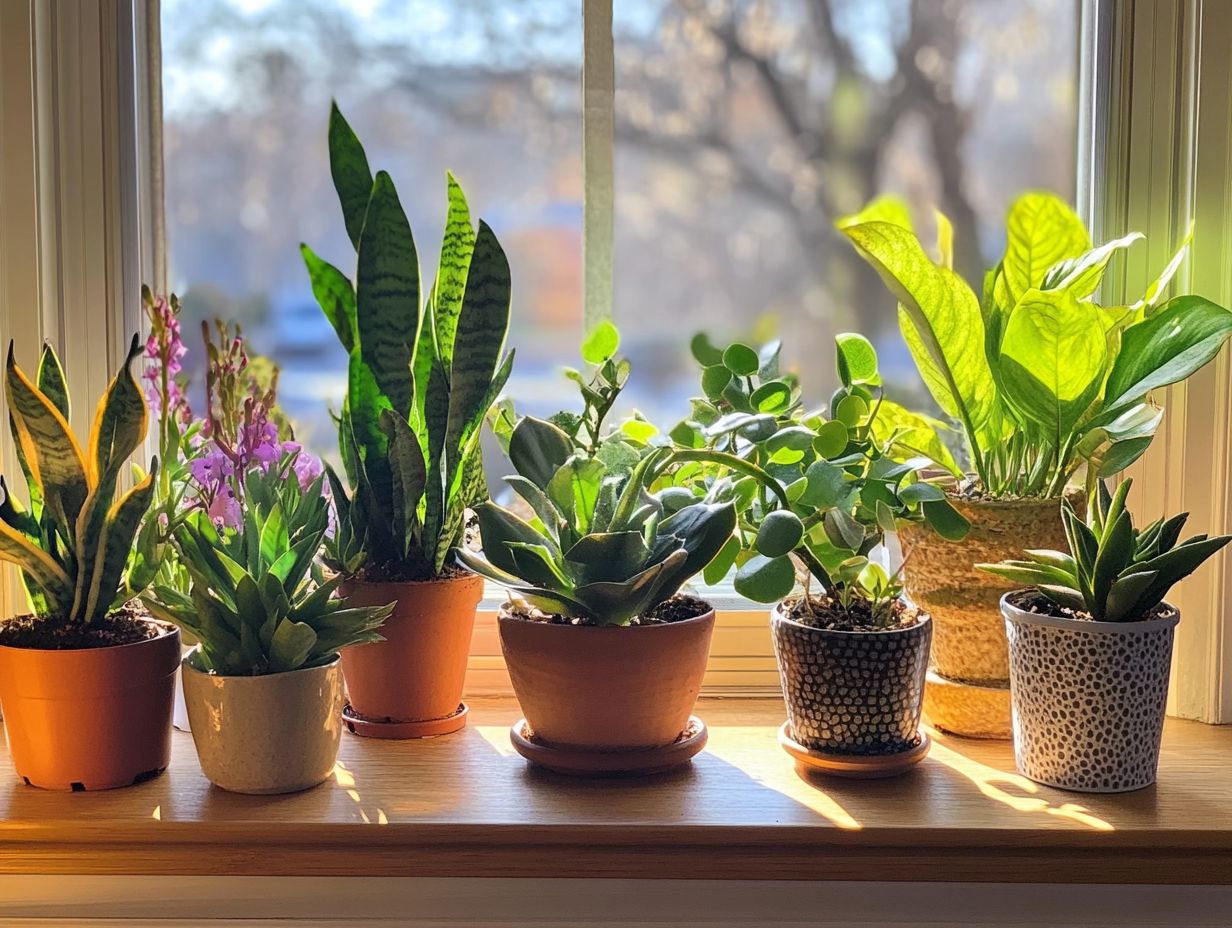
The Rubber Plant, or Ficus elastica, stands out as a versatile indoor companion that flourishes in bright light. Its large, glossy leaves not only elevate your home decor but also play a vital role in enhancing air quality. It s no wonder this plant has captured the hearts of indoor gardening enthusiasts who value both aesthetic appeal and practicality.
For the best results, place your Rubber Plant in bright, indirect sunlight, as direct rays can scorch those lovely leaves. For those looking to enhance their indoor gardening, consider exploring the best indoor plants for north-facing windows. Watering should be done with care; allowing the top inch of soil to dry out between waterings is key to preventing root rot.
Choosing the right soil mix is essential. Opt for well-draining potting soil enriched with perlite or sand to boost aeration. Since Rubber Plants thrive in higher humidity levels, aim for around 40-60% humidity to support their growth beautifully.
Regularly pruning your plant not only encourages a fuller shape but also helps remove any dead or damaged leaves. If you re looking to expand your indoor garden, propagation through stem cuttings is a straightforward process that can lead to exciting new additions.
8. Ponytail Palm
The Ponytail Palm, or Beaucarnea recurvata, stands out as a captivating indoor plant native to tropical regions, boasting a thick trunk and long, flowing leaves. Flourishing best in bright light, it requires minimal watering, making it an appealing and low-maintenance option for those wishing to infuse a hint of the tropics into their home.
This resilient tropical beauty thrives in well-draining soil, especially a cactus or succulent mix that allows for optimal airflow around its roots. It s important to maintain low to moderate humidity levels, as excess moisture can lead to root rot a fate best avoided, particularly for plants like the Aloe Vera and Jade Plant.
With a slow and steady growth pattern, it typically reaches heights of 3 to 4 feet indoors. If you’re keen on propagation, you can easily achieve this through offsets or seeds, ensuring that your new plants inherit those same striking characteristics.
Keep an eye out for pesky visitors like spider mites and mealybugs; while they may occasionally show up, a proper care routine will keep them at bay and manageable. Be aware of plant toxicities, as some like the African Milk Tree can pose risks to pets.
9. Ficus
Ficus, a captivating genus of indoor plants, provides you with an impressive array of options that flourish in various light conditions, making them a quintessential choice for those looking to enrich their living spaces with vibrant greenery. To keep your Ficus thriving, follow these simple care tips!
Ficus lyrata, better known as the Fiddle-Leaf Fig, truly shines with its large, glossy leaves that can elevate the aesthetic of any room in an instant. This popular species thrives in bright, indirect light, and using light shades for indoor plants can help optimize its growth. Water it moderately, allowing the soil to dry out between sessions to avoid root rot. This makes it a fantastic addition alongside the Snake Plant and Ponytail Palm.
On the other hand, Ficus elastica, or the Rubber Plant, enjoys similar care but tends to be more forgiving regarding light exposure. Both varieties may be prone to pests like spider mites tiny pests that can harm your plants and scale, making regular inspections essential.
You can propagate these plants easily. Often, you can grow new plants by cutting a stem and placing it in water or soil, creating an engaging opportunity to expand your collection and deepen your connection with these remarkable plants.
10. Peace Lily
The Peace Lily stands out as a beloved indoor plant, renowned for its elegant white blooms and impressive air-purifying abilities. It thrives in a range of lighting conditions, from low to bright light, and requires consistent moisture, making it a perfect choice for anyone looking to elevate their indoor environment with both aesthetic appeal and functionality.
To meet its watering needs, keep the soil slightly moist but avoid waterlogging, as that could lead to root rot, especially in plants like the Areca Palm. Ideally, this plant does best in a well-draining potting mix enriched with organic matter, ensuring exceptional aeration.
While the Peace Lily can tolerate low-light settings, it tends to flaunt more blooms in brighter, indirect sunlight, similar to the Papyrus and Croton. For those looking for options, there are many indoor plants that thrive in low light. Beyond its beauty, this remarkable plant acts as a natural air purifier, filtering out toxins and enhancing indoor air quality.
Therefore, maintaining proper care monitoring moisture levels and ensuring adequate light exposure is crucial to prevent wilting and keep it thriving beautifully.
11. Philodendron
Philodendron is a versatile and resilient indoor plant, celebrated for its lush green foliage and impressive adaptability to various light conditions. This makes it a top choice for anyone looking to create a tropical oasis in their home with minimal maintenance.
Among the numerous varieties, the Philodendron hederaceum stands out with its heart-shaped leaves, thriving in moderate light and requiring higher humidity to keep its vibrant appearance. In contrast, the Philodendron selloum, with its striking fronds, prefers bright, indirect light but shows a remarkable tolerance for lower humidity levels. For those looking to enhance their space, consider the top 5 indoor plants for bright spaces, making it a resilient choice like the Dragon Tree.
In terms of watering, most philodendrons do best when the top inch of soil has dried out, typically needing hydration only every two weeks during the growing season. For propagation, techniques such as stem cuttings or air layering can easily stimulate growth, allowing you to expand your collection while ensuring a steady supply of these delightful plants.
12. Chinese Evergreen
The Chinese Evergreen, scientifically known as Aglaonema, is a striking indoor plant that flourishes in a variety of lighting conditions, from low to bright light. It easily competes with Hens and Chicks in popularity for its easy care. This versatility makes it a favorite for those desiring vibrant greenery that also purifies the air.
To ensure your plant reaches its full potential, aim for moderate humidity keeping the air moist is key! You can achieve this by misting your plant regularly or using a humidifier.
When it comes to watering, let the top inch of soil dry out before watering again to prevent dreaded root rot. Don’t forget! This plant is toxic to pets; ingestion can cause discomfort or more serious health issues.
Be quick to address common pests like spider mites and mealybugs, as they may take a liking to your plant. Regular inspections for signs of infestation will help you maintain its health and vibrancy, just as you would for plants like Moon Cactus or Coral Cactus.
13. Monstera
Monstera, specifically Monstera deliciosa, is a tropical indoor plant that you ll quickly admire for its dramatic foliage and striking leaf perforations. It thrives in bright, filtered light, bringing an exotic flair to any indoor space. This makes it a top choice for both novices and experienced indoor gardeners, particularly those who appreciate plants like Ti Plant and Golden Barrel Cactus.
To ensure your Monstera grows optimally, maintain a humidity level of at least 60%. This plant loves warm, humid environments that mirror its native tropical habitat. You’ll notice that Monstera has a climbing growth pattern, so it might need some support for its aerial roots. Regular pruning will encourage a bushier, more robust appearance.
Propagation is easy! You can grow new plants through stem cuttings, which will root successfully in water or soil. Don t forget to regularly check for pests like spider mites or mealybugs. A quick treatment with insecticidal soap can keep these unwelcome guests at bay, ensuring your Monstera remains healthy and thriving.
14. Pothos

Pothos, or Epipremnum aureum, is a standout choice among indoor plants, renowned for its heart-shaped leaves and cascading vines. This resilient beauty thrives in varying light conditions and requires minimal care, making it perfect for anyone looking to infuse their indoor space with vibrant greenery that also purifies the air.
Pothos prefers indirect sunlight but is quite adaptable, comfortably settling into low-light environments. In terms of watering, allow the top inch of soil to dry out between sessions to prevent root rot.
Propagation is a breeze! Just take cuttings and place them in water, where they ll sprout roots within weeks. This species enhances your decor with its lush aesthetic and doubles as an air purifier, filtering out harmful toxins and contributing to a healthier indoor atmosphere.
15. Bird of Paradise
The Bird of Paradise, with its stunning tropical flowers and dramatic foliage, is an impressive indoor plant that thrives in bright light and craves higher humidity. If you’re looking to create a vibrant, tropical oasis in your home, this plant, like the Yucca Plant and the Meyer Lemon, is an excellent choice.
To ensure this magnificent beauty flourishes, establish a consistent watering routine, allowing the top inch of the soil to dry out between sessions. Ideally, it enjoys a humidity level of at least 60%, so clustering it with other plants or placing it near a humidifier can work wonders.
In terms of lighting, bright, indirect sunlight is essential. A few hours of direct sunlight can encourage those stunning blossoms. If you’re interested in propagation, dividing the plant during the growing season is a reliable method.
Be quick to address common issues like spider mites, aphids, and other pests. Addressing these promptly will help maintain its vibrant appearance. Bring home a Bird of Paradise today and enjoy its beauty!
How to Care for Indoor Plants That Require Bright Light?
Caring for indoor plants that thrive in bright light requires a keen understanding of their unique needs regarding light exposure and watering routines.
By mastering these elements, you ensure their vibrant growth and enhance your indoor gardening experience, creating a positive atmosphere in your home.
Selecting the right plants for bright light is crucial and can significantly impact their growth and overall health. To gauge their watering needs, simply observe the top inch of the soil; if it feels dry, it s time to hydrate. Many plants, including Hibiscus and Gardenia, thrive on this method.
However, be cautious over-watering can lead to detrimental effects.
Choosing the right soil is also important, as it provides important nutrients and promotes adequate drainage. Don t miss out invest in grow lights to give your plants the boost they need if you find that natural light isn t enough. Humidity trays help maintain moisture in the air around plants, and misting can create a more favorable environment for your plants.
What Are the Benefits of Having Indoor Plants?
Having indoor plants offers an array of benefits, from purifying the air to enhancing the aesthetic appeal of your space. These lively plants bring a beautiful balance to your home, contributing to better humidity levels and overall well-being.
Not only do they filter toxins from the air, but they also release oxygen, fostering a healthier atmosphere for you to enjoy.
Their remarkable ability to reduce stress allows you to feel more relaxed and at ease in your surroundings. Research has shown that having plants around can significantly boost your focus and concentration, making them the perfect addition to your workspace.
By incorporating these vibrant elements into your decor, you elevate the overall vibe of your space. The psychological boost you gain from nurturing these plants, such as the top 5 indoor plants for east-facing windows, adds to your happiness, making indoor greenery an essential and delightful necessity for any home.
What Are the Different Types of Bright Light Indoor Plants?
Numerous indoor plants flourish in bright light, and you have a delightful selection to choose from, including Aloe Vera, Jade Plant, Rubber Plant, and Bird of Paradise.
Each of these species presents its own unique aesthetics and care requirements, catering to both novice and seasoned indoor gardeners alike.
These vibrant plants do more than just brighten your space with their lush foliage; they also enhance indoor air quality. Take Aloe Vera, for example. This resilient plant thrives in well-draining soil and requires minimal watering, making it a perfect choice for those who may occasionally forget their watering schedule. To ensure your indoor plants get the best care, consider the best light sources for indoor plants.
The Jade Plant is equally low-maintenance, needing only infrequent watering and plenty of indirect sunlight to flourish. Then there’s the Rubber Plant, known for its striking, glossy leaves. It thrives in bright, filtered light and should only be watered when the top inch of soil feels dry. For those seeking options that thrive in less light, consider exploring low light indoor plants.
In contrast, the Bird of Paradise adds a bold tropical flair to your home, thriving in bright, direct light while needing regular watering during its growing season. Understanding indoor plant light needs is crucial, as each of these indoor plants showcases unique characteristics and adapts seamlessly to a variety of indoor environments, making them an excellent addition to your living space.
What Are the Common Mistakes When Taking Care of Bright Light Indoor Plants?
When caring for bright light indoor plants, you may encounter common mistakes that can hinder your gardening success. Insufficient watering, incorrect lighting conditions, and neglecting soil quality can lead to unhealthy plants and limit their growth potential.
To steer clear of these pitfalls, it s essential to establish a consistent watering schedule. This ensures your plants receive the right amount of moisture neither drowning in waterlogged soil nor suffering from dehydration.
Understanding each plant’s specific light requirements is also important; while some may bask in direct sunlight, others thrive in filtered light. Choosing high-quality soil that caters to your plants’ needs can significantly enhance root health and overall vitality.
By honing in on these key factors, you can cultivate a flourishing indoor environment that nurtures your green companions and elevates your gardening experience. Start your indoor gardening journey today!
How Can One Incorporate Bright Light Indoor Plants into Their Home Decor?
Incorporating bright light indoor plants into your home decor elevates both aesthetics and ambiance. They transform your spaces into inviting sanctuaries filled with natural beauty. Not only do they enhance the visual appeal, but they also contribute to air quality and overall wellness making them a splendid addition to any room.
When planning your arrangement, consider the size and layout of each space. In rooms that get plenty of natural light, taller plants can be positioned in corners to draw the eye upward, adding a sense of dimension. Additionally, it’s important to understand indoor light levels and plant selection. Smaller plants can grace shelves or tables, creating a delightful layered effect.
Selecting complementary planters is essential. Choose materials and colors that harmonize seamlessly with your existing decor. Think ceramic pots for that rustic charm or sleek metallic options for a modern flair both can work wonders.
Grouping plants at different heights adds visual interest and creates a balanced look throughout your living areas.
Frequently Asked Questions
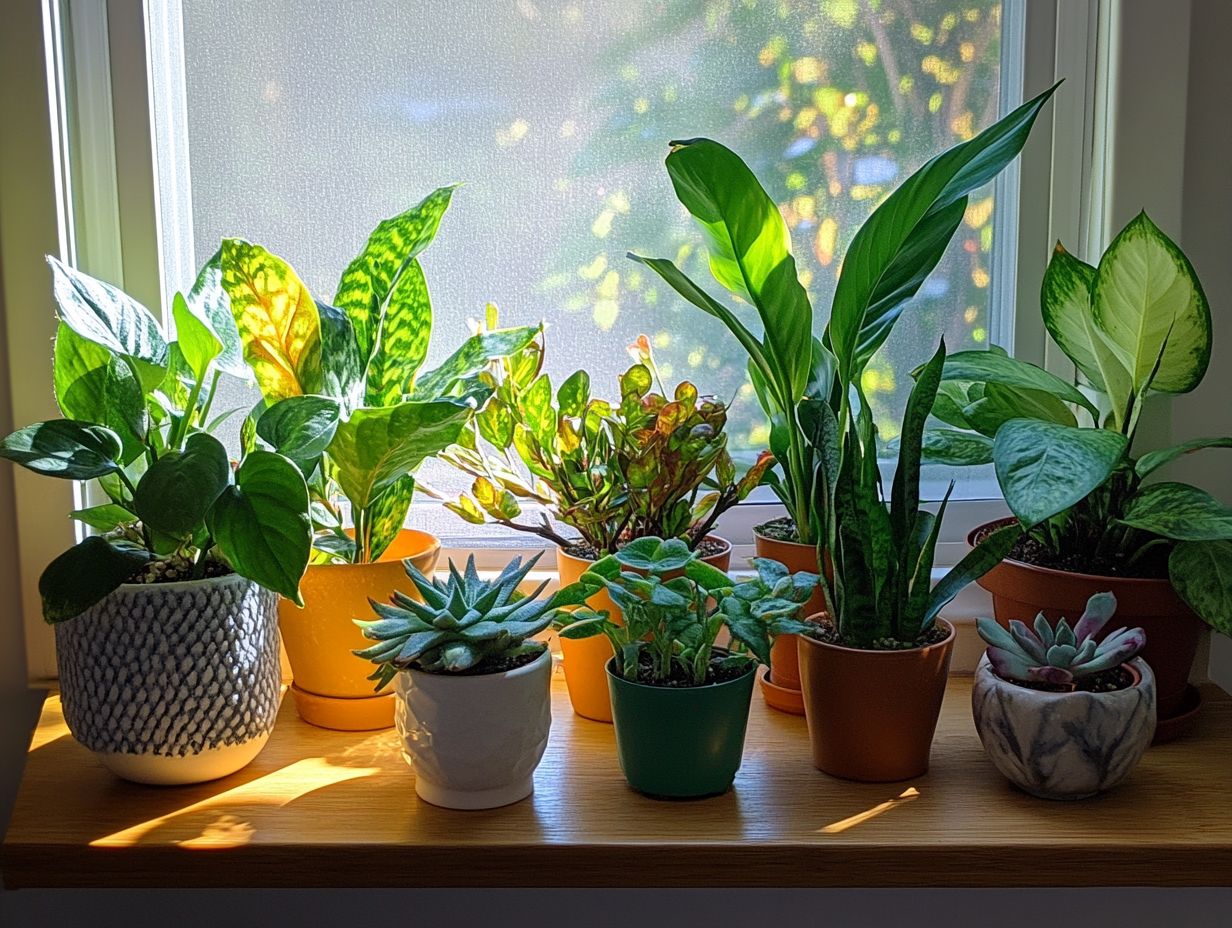
Curious about the best indoor plants for bright light?
Discover amazing indoor plants that thrive in bright light, like cacti, succulents, spider plants, dracaenas, and ZZ plants.
Can I place my indoor plants in direct sunlight?
It depends on the type of plant. Some indoor plants can withstand direct sunlight, while others may get burned or wilted. It’s best to research the specific needs of your plant before placing it in direct sunlight.
How much light do indoor plants need?
Indoor plants that thrive in bright light typically need at least 6-8 hours of sunlight per day. However, some plants may require more or less depending on their species.
What are some low-maintenance indoor plants for bright light?
If you’re looking for low-maintenance indoor plants that can tolerate bright light, consider getting aloe vera, jade plant, or snake plant. These plants require minimal care and can thrive in bright light conditions.
Can I use artificial light for my indoor plants?
Yes! You can use artificial light for your indoor plants. LED grow lights provide the right type of light for plants to grow indoors.
What are some signs that my indoor plant is not getting enough light?
If your indoor plant is not getting enough light, you may notice stunted growth, yellowing leaves, or leaves dropping off. These are signs that your plant needs more light to thrive.
Ready to transform your home with beautiful indoor plants? Start your journey today!

